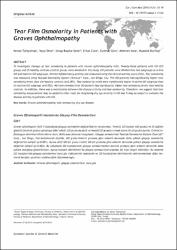Tear film osmolarity in patients with graves ophthalmopathy

Göster/
Erişim
info:eu-repo/semantics/openAccessTarih
2014Yazar
Türkyılmaz, KemalÖner, Veysi
Şahin, Serap Baydur
Cüre, Erkan
Cüre, Cumhur
Kola, Mehmet
Durmuş, Mustafa
Üst veri
Tüm öğe kaydını gösterKünye
Turkyilmaz, K., Oner, V., Sahin, S.B., Cure, E., Cure, C., Kola, M., Durmus, M., (2014). Tear Film Osmolarity in Patients with Graves Ophthalmopathy. European Journal of General Medicine, 11(1), 15-19. https://doi.org/10.15197/sabad.1.11.04Özet
To investigate changes of tear osmolarity in patients with Graves ophthalmopathy (GO). Twenty-three patients with GO (GO group) and 25 healthy controls (control group) were enrolled in the study. GO patients were divided into two subgroups as active GO and inactive GO subgroups. Orbital inflammatory activity was evaluated using the clinical activity score (CAS). Tear osmolarity was measured using TearLab Osmolarity System (TearLab™ Corp., San Diego, CA). The GO patients had significantly higher tear osmolarity levels than the healthy controls (p<0.001). Tear osmolarity levels were significantly higher in active GO subgroup than in inactive GO subgroup (p=0.003). We have revealed that GO patients had significantly higher tear osmolarity levels than healthy controls. In addition, there was a relationship between the disease activity and tear osmolarity. Therefore, we suggest that tear osmolarity measurement may be added to other tests for diagnosing dry eye severity in GO and it may be useful to evaluate the disease activity in patients with GO.

















